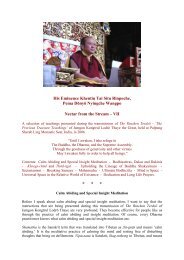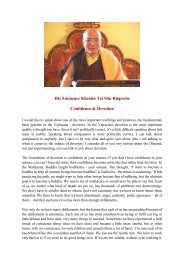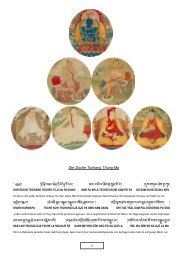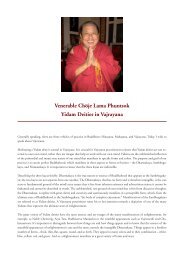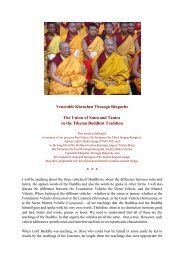Acharya Lama Kelzang Wangdi White Arya Tara - Karma Sherab Ling
Acharya Lama Kelzang Wangdi White Arya Tara - Karma Sherab Ling
Acharya Lama Kelzang Wangdi White Arya Tara - Karma Sherab Ling
You also want an ePaper? Increase the reach of your titles
YUMPU automatically turns print PDFs into web optimized ePapers that Google loves.
We normally don’t just offer water in the offering bowls, but usually have eight offering<br />
bowls placed in a row that we fill with many nice things. We fill the first bowl with water for<br />
drinking and the second bowl with clean water that represents washing the feet. We fill rice or<br />
another grain into the third bowl and place a flower on it. We also fill rice into a fourth bowl<br />
and stick incense that represents the sense of smell into it, the number depending on the size<br />
of the bowl, usually about 4 or 5 sticks. Then we have a butter lamp or a candle; we should be<br />
careful and not let the candle burn when we aren’t practicing anymore and when we leave the<br />
room. We place a bottle of perfume or fragrance on top of the sixth bowl that is also filled<br />
with rice. Then we place delicious food, e.g., an apple or an orange, on the seventh bowl that<br />
is also filled with rice. Sometimes we make a torma (‘a symbolic ritual object’ that represents<br />
food and is often made of flour, wood, or precious metal). We also fill the eighth bowl with<br />
rice and place a conch shell or other object that represents music on it, e.g., cymbals or a bell.<br />
When we meditate in front of the shrine, it should be arranged nicely so that we have a good<br />
atmosphere for the material offerings that we placed in the offering bowls. If we aren’t<br />
allergic, we can light incense so that the atmosphere is peaceful and nice. We leave the rice<br />
and offerings in the bowls, but in the evening we have to empty the water from the bowls,<br />
wipe them dry with a clean clothe reserved for this purpose, and turn the bowls over. We fill<br />
them with water again the next morning.<br />
We are used to making three prostrations in front of our shrine before we begin a practice. In<br />
this way, we demonstrate our physical involvement. Then we sit on our cushion and practice.<br />
- Reciting the Lineage Supplication -<br />
We begin any practice we do with the supplication to the Lineage from whom the practice we<br />
are doing originated and through whom it has been passed down to us. We connect with and<br />
receive the blessings of the Lineage by reciting the specific supplication prayer to the<br />
Lineage, which differ in each school. Our meditation practice involves our body, our speech,<br />
and our mind, so we fold our hands at our heart when we sing The Supplication Prayer to the<br />
Lineage of <strong>White</strong> <strong>Tara</strong>. The first line of the Sadhana is the homage to <strong>White</strong> <strong>Tara</strong> in Sanskrit:<br />
“Namo Guru <strong>Arya</strong> <strong>Tara</strong> Ye.”<br />
The homage to <strong>White</strong> <strong>Tara</strong> is followed by the names of the great masters who held the<br />
Lineage of the practice. It describes how the inner transmission happened. We recite it so that<br />
we think about and try to feel the Lineage in our heart.<br />
The Supplication Prayer to the Lineage of <strong>White</strong> <strong>Tara</strong> closes with the line: “This supplication to the Lineage of<br />
the daily practice of <strong>White</strong> <strong>Tara</strong> was composed by <strong>Karma</strong> Ngawang Yönten Gyatso, Jamgon Kongtrul, in<br />
accordance with the wishes of <strong>Karma</strong> Lhapäl, one of unequalled, pure faith. Mangalam – May there be good<br />
fortune!”<br />
Now comes the practice section. There are three stages of every Sadhana practice. They are:<br />
the preliminary practices, the main practice, and the concluding practice.<br />
6



